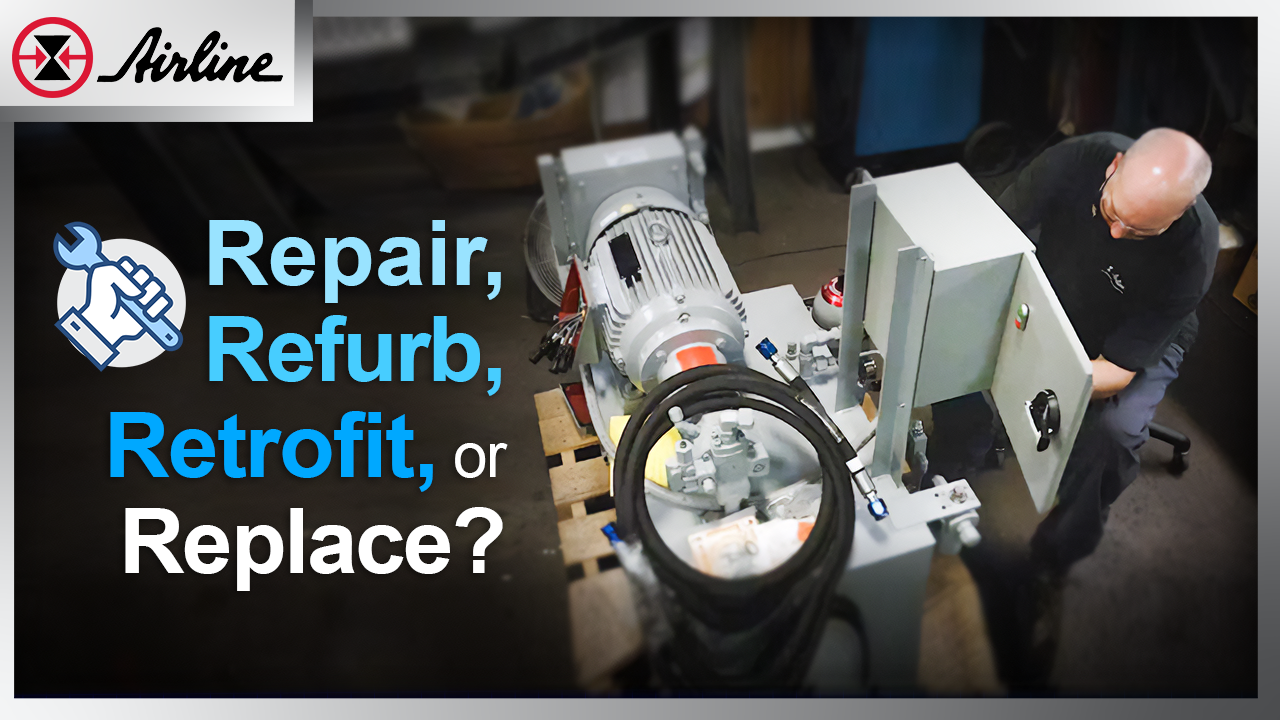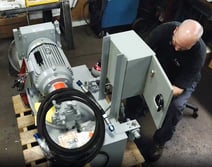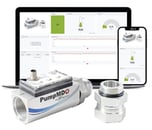As a machine owner, you know system failures cost thousands of dollars in downtime per day, so it’s imperative to quickly remedy the situation with the most sensible and cost-effective solution.
But several options exist to get your system back online, bringing it back to it's initial state or even better than before. So should your machine simply be repaired, or will upgrading yield the most benefits in the long-term? In today’s informative blog post, you'll learn how to determine the best solution for you: repair, refurb, retrofit, or replace?
Jump to Section:
Repair Refurbish Retrofit Replace How to decide the best option Tips to use time wisely
First, let's go over your options
1. Repair
Repairing means fixing what is in disrepair to bring it to the exact same state the machine/system was in before it broke. Items are replaced if broken beyond repair, but not upgraded. After a repair, the machine/system should work exactly as it did before it broke - no better, no worse. Simple repairs are a great option to get you machine/system back online, simple as that.
|
2. Refurbish
Think of refurbishment as a "facelift" for your machine/system. This is when it goes through the same steps above for repair, but it's also improved through a thorough cleaning, tuning, and re-equipping. Systems that go through refurbishment may be many years old, but after, look and perform like it did when it was new!
Here's a video that walks through the before vs. after of a refurbished HPU:
3. Retrofit
When a machine or system goes through a retrofit, a new component or feature is installed that was not originally designed into the system. This usually adds new functionalities it did not have when originally made. For example, older machines/systems can be retrofitted with newer tech to reap the benefits of cutting-edge advancements like io-link, predictive maintenance, remote connectivity, and more!
|
4. Replace
Replacing a system/machine is when you disconnect it from your operations and replace it with a completely new one. A newly-built machine is often more productive, runs more efficiently with less energy consumption and noise, is better fitted towards machine safety standards, (although a risk assessment is usually still required for full compliance), and is fitted with newer components with better performance and durability (with proper maintenance, of course).
Think it will take forever to get a new system built? That's not always the case! Here's a video that shows the timelapse of a new power unit build - the process is down to a science!
|
Need a new system?
• Design and build units custom to your application.
|
How to decide the best option: repair, refurb, retrofit, or replace
Here are some important questions to consider when deciding whether to repair, refurb, retrofit, or replace.
1. What's your timeline?
Ideally, you would want to consider machine refurbs and upgrades during scheduled machine maintenance periods, allowing ample time to implement the best and most cost-efficient course of action. But if you're in a dire machine-down situation where you need the machine running again ASAP, you might be limited in options and just go for the fastest repair.
If you find yourself in dire machine-down situations, consider retrofitting predictive-maintenance technologies into your system for next time. It may cost a little extra at first, but will be worth it in the long run when you're not stuck in the same pickle next time (and losing revenue from unplanned downtime).
|
2. How was your system performing before any breaks?
Was your system performing just fine, or do you need increased speed, precision, or other performance gains? If your machine has been running great, a simple repair may be all that's required. But if your machine's performance has been poor, you might want to consider refurbishing, retrofitting, or replacing the unit to get it up to snuff with your production needs.
3. Is your system overconsuming energy?
Older machines/systems can be energy hogs. If you're tired of paying steep energy bills, consider an upgrade with either retrofitting or replacing the system, as modernized machinery is more energy efficient.
4. Can you hear me? How loud is your machine?
If your machine is ungodly loud, upgraded equipment often operates more quietly. There are also elements that can be installed in a retrofitted machine that can help quiet noise.
How to reduce hydraulic noise and save energy
|
Tips to use your maintenance time wisely!
If you have the opportunity to do so, here are some ways to make the most of planned downtime.
Get proactive instead of reactive.
Predictive maintenance technologies are easier and more affordable than ever! Components that monitor system performance can be installed on almost any machine, allowing maintenance to know when something's wrong before it breaks. (No crystal ball needed!)
Systems can also be outfitted with automated equipment to perform machine lubrication and other routine or preventative maintenance tasks. Compared to simply repairing a part, the long-term saving rewards often outweighs the initial cost of upgrading components and technologies.
Buy some spare parts while you're at it!
When your machine is down, you don't want to waste time by scrambling to your purchasers to source components ASAP. In worst case scenarios, the part you need isn't in stock, and any wait is excruciating when you're watching production dollars go down the drain. So think ahead and have spare parts available to allow your maintenance team or repair facility to provide a quicker response to your service needs.
Explore Airline's online selection of hydraulic OEM replacement parts
Is your machine compliant with safety standards? Now's the time to check!
While waiting for a machine to get back on commission, it can be an opportunity to ensure it's up to code with applicable machine safety standards. You may want to consider an inspection, and/or upgrade any out-of-date machine safety devices.
Here's where to get started to learn about machine safety.
|
Summary
System failures cost thousands of dollars in downtime per day. The choice is yours to do a simple repair, but definitely consider the longer-term benefits of refurbishing, retrofitting, or even replacing older and out-of-date machines with one that will save your money in the long-run. And always remember, you have a partner in Airline to help with any option you choose.
Resources & Information
Repair and Field Services at Airline
System Engineering Services at Airline
Pump Predictive Maintenance with PumpMD
How to Lower Hydraulic Noise and Save Energy
Machine Safety Resources
Turnkey Machine Safeguarding - MPSA
Recorded Webinar, "How Do I Know if My Machine is Safe and Compliant?"
Related Videos
Hydraulic Power Unit Build Timelapse
Hydraulic Power Unit Refurbishment
Explore Products
Hydraulic OEM Replacement Parts








 We make it easy to schedule your repair pickup online with our Red Pallet Program. Schedule a repair on your phone, tablet, or computer, and you will be contacted promptly with details regarding the pickup of your components.
We make it easy to schedule your repair pickup online with our Red Pallet Program. Schedule a repair on your phone, tablet, or computer, and you will be contacted promptly with details regarding the pickup of your components.
 For over half a century, Airline has manufactured hydraulic power units and other systems with the highest reputation for engineering excellence. We can:
For over half a century, Airline has manufactured hydraulic power units and other systems with the highest reputation for engineering excellence. We can:
 If the pump is the heart of a hydraulic system, PumpMD™ is a monitor that warns you about cardiac arrest, before it's life-threatening. Learn how it easily provides
If the pump is the heart of a hydraulic system, PumpMD™ is a monitor that warns you about cardiac arrest, before it's life-threatening. Learn how it easily provides





Leave Comment